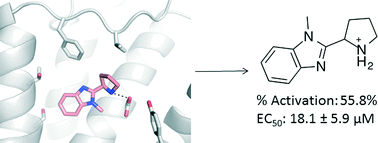Discovery of trace amine-associated receptor 1 ligands by molecular docking screening against a homology model†
Abstract
Trace Amines (TA) are side-products of the synthesis of classical neurotransmitters within the brain. TAs exert their effect by binding to a family of G protein-coupled receptors termed Trace Amine-Associated Receptors (TAARs). TAAR1 is the best characterised member of this family and studies on TAAR1 have shown that this receptor is a negative regulator of dopamine transmission. Considering the limited number of pharmacological probes available for TAAR1, we aimed to identify novel ligands of this receptor using structure-based virtual screening. A homology model of TAAR1 was generated and over three million commercially available compounds were screened against the orthosteric site using molecular docking. Among the 42 top-ranked compounds that were tested in functional assays, three partial agonists with EC50 values ranging from 1 to 52 μM were discovered. In addition, four potentially weak antagonists were identified. Ten analogs of the two most potent agonists from the screen were also evaluated and three of these displayed equal or greater activity compared to the parent compound. Several of the discovered ligands represent novel scaffolds and are thus promising starting points for development of new pharmacological tools for studying TAAR1 biology.


 Please wait while we load your content...
Please wait while we load your content...